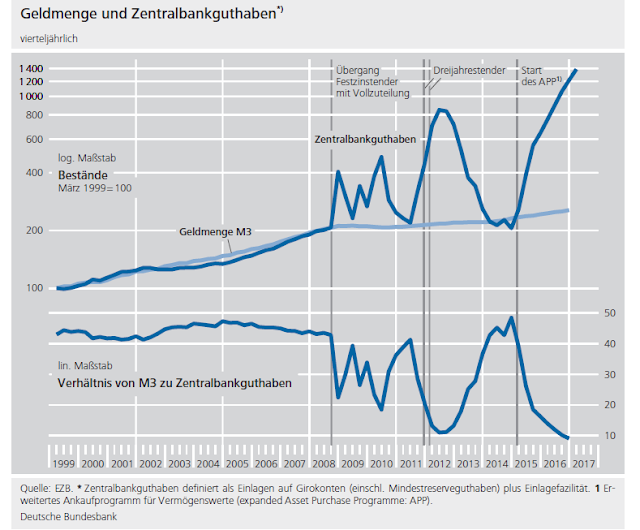 |
| Image credit. |
My own, unauthorised translation of the below German text which is available from the Bundesbank here.
Continued from here.
The Role of Central Bank Reserves
The foregoing examination of interaction between banks and the central bank has not taken into account the volume of reserves held by banks at the central bank. Yet, they play a significant role in implementing the central bank's interest rate policy: For a central bank pursuing an interest rate policy, the volume of central bank reserves is not an independent variable, but results from the banks' demand for reserves at the prevailing interest rate. (33)
The central bank makes an estimate of the demand for central bank reserves at the prevailing rates and engages in monetary policy operations to accommodate the demand. (34)
In this way, the central bank ensures that money market rates are in line with the policy rates set by the central bank—the first stage in the monetary transmission process.
Thus, in this process, the central bank does not restrict the quantity of central bank reserves regardless of its interest rate policy.
Should signals emerge from the development of the money supply and lending and the resultant demand for central bank reserves that indicate threats to price stability, the central bank adjusts its monetary policy rates.
Therefore, the supply of central bank reserves is elastic/accommodative only to the extent that it is compatible with a monetary policy stance that the central bank considers consistent with price stability.
The relationship between the M3 money supply and central bank reserves reflects the interaction of different agents; if banks or non-banks alter their conduct and depending on the course taken by monetary policy, the relationship may change temporarily or permanently. (35)
In order to assess and explain these changes, it is therefore necessary to understand the behaviour of the involved sectors and the interaction between them.
In times of conventional monetary policy, that is, until the beginning of the global financial crisis, the M3 money supply and central bank reserves evolved largely in tandem.
Subsequent marked fluctuations in the relationship between the M3 money supply and central bank reserves are closely related to the non-standard monetary policy measures adopted in the Eurosystem, most recently in the form of the Asset Purchase Programme (see below chart and here):
In statu nascendi - footnotes to be added.
— — —
Zur Rolle der Zentralbankguthaben
Das Volumen der von den Banken gehaltenen Zentralbankguthaben wurde in den bisherigen Überlegungen zur Interaktion zwischen Banken und Zentralbank nicht berücksichtigt.
Sie spielen jedoch bei der Implementierung der Zinspolitik der Zentralbank eine wichtige Rolle: Das Volumen an Zentralbankguthaben ist für eine Zentralbank, die eine Zinssteuerung betreibt, keine unabhängige Größe, sondern ergibt sich aus der Nachfrage der Banken zum jeweiligen Zinssatz. (33)
Die Zentralbank schätzt also die Nachfrage nach Zentralbankguthaben zu den von ihr gesetzten Zinssätzen und befriedigt sie im Rahmen ihrer geldpolitischen Operationen. (34)
Auf diesem Weg stellt sie sicher, dass sich die Geldmarktzinsen im Einklang mit den von ihr gesetzten Leitzinsen entwickeln, was den ersten Schritt im geldpolitischen Transmissionsprozess bildet. Die Notenbank restringiert also in diesem Prozess nicht die Menge an Zentralbankguthaben unabhängig von ihrer Zinspolitik.
Signalisieren die Geldmengen- und Kreditentwicklung und die daraus resultierende Nachfrage nach Zentralbankguthaben Risiken für die Preisstabilität, so passt die Zentralbank ihre geldpolitischen Zinssätze an.
Das Angebot an Zentralbankguthaben ist folglich nur für eine gegebene, aus Sicht der Zentralbank mit Preisstabilität konsistente geldpolitische Ausrichtung elastisch.
Die Entwicklung des Verhältnisses der Geldmenge M3 zu Zentralbankguthaben reflektiert das Handeln der verschiedenen Akteure und kann sich bei Verhaltensänderungen der Banken oder Nichtbanken sowie in Abhängigkeit von der Umsetzung der Geldpolitik vorübergehend oder dauerhaft verändern. (35)
Für die Einschätzung und Erklärung dieser Veränderungen ist es daher erforderlich, die dahinterstehenden Verhaltensweisen der beteiligten Sektoren und ihre Interaktion zu verstehen.
Sie spielen jedoch bei der Implementierung der Zinspolitik der Zentralbank eine wichtige Rolle: Das Volumen an Zentralbankguthaben ist für eine Zentralbank, die eine Zinssteuerung betreibt, keine unabhängige Größe, sondern ergibt sich aus der Nachfrage der Banken zum jeweiligen Zinssatz. (33)
Die Zentralbank schätzt also die Nachfrage nach Zentralbankguthaben zu den von ihr gesetzten Zinssätzen und befriedigt sie im Rahmen ihrer geldpolitischen Operationen. (34)
Auf diesem Weg stellt sie sicher, dass sich die Geldmarktzinsen im Einklang mit den von ihr gesetzten Leitzinsen entwickeln, was den ersten Schritt im geldpolitischen Transmissionsprozess bildet. Die Notenbank restringiert also in diesem Prozess nicht die Menge an Zentralbankguthaben unabhängig von ihrer Zinspolitik.
Signalisieren die Geldmengen- und Kreditentwicklung und die daraus resultierende Nachfrage nach Zentralbankguthaben Risiken für die Preisstabilität, so passt die Zentralbank ihre geldpolitischen Zinssätze an.
Das Angebot an Zentralbankguthaben ist folglich nur für eine gegebene, aus Sicht der Zentralbank mit Preisstabilität konsistente geldpolitische Ausrichtung elastisch.
Die Entwicklung des Verhältnisses der Geldmenge M3 zu Zentralbankguthaben reflektiert das Handeln der verschiedenen Akteure und kann sich bei Verhaltensänderungen der Banken oder Nichtbanken sowie in Abhängigkeit von der Umsetzung der Geldpolitik vorübergehend oder dauerhaft verändern. (35)
Für die Einschätzung und Erklärung dieser Veränderungen ist es daher erforderlich, die dahinterstehenden Verhaltensweisen der beteiligten Sektoren und ihre Interaktion zu verstehen.
So entwickelten sich die Geldmenge M3 und die Zentralbankguthaben zu Zeiten konventioneller Geldpolitik, das heißt bis zum Beginn der globalen Finanzkrise, weitgehend im Einklang miteinander. Die seitdem zu beobachtenden starken Fluktuationen des Verhältnisses von Geldmenge M3 zu Zentralbankguthaben stehen in engem Zusammenhang mit den ab dem Jahr 2008 ergriffenen geldpolitischen Sondermaßnahmen des Eurosystems, zuletzt mit dem geldpolitischen Ankaufprogramm (siehe Schaubild auf S. 16)
Continued here.
Continued here.

No comments:
Post a Comment